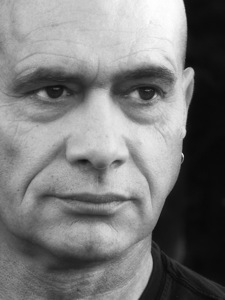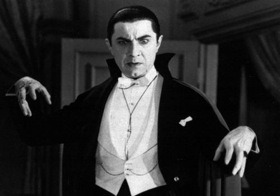Tracking the vampire in myth, culture and politics
After Tomislav Longinovic left his homeland, Yugoslavia splintered into seven nations.
Although Longinovic is now an American citizen, the trauma of multiple, violent separations persists. “I’m almost a man without a country. Because of ethnicity, I would be a Serb, but I hate the idea of what nationalism did to Yugoslavia,” he says.

Longinovic
A decade of civil wars, particularly in Bosnia and Kosovo, cost thousands of lives and added “ethnic cleansing” to the lexicon of sanguinary euphemism. In 2006, Slobodan Milosevic, the former president of Yugoslavia and then Serbia, died while on trial for war crimes and genocide.
Longinovic, a professor of Slavic languages at UW–Madison, felt that history had imposed on him a burden of explanation: How could a nation with so much culture and history disappear in such bloody fratricide at the end of the 20th century?
Could the answer reside solely in the rational assessments by which people supposedly make political choices? Or could it reside in the realm that Longinovic calls the “imaginary?”
In their own imagination, nations require roots, history, purpose and longevity, he says, what could be called a “bloodline.” In many ways, that reminded him of the myth of the vampire – the humanoid creature that drinks blood to achieve immortality.
Metaphorically speaking, he realized, nations “drink” the blood of the young warriors they send into battle.
Longinovic (Toma to friends) was born in 1955 and raised in Belgrade, capital of the former Yugoslavia by a father who was an actor and architect and a mother who was a clinical biochemist. He came to the United States in 1982 to study creative writing at the University of Iowa, then came to Madison to teach in 1990.
Longinovic has two daughters, Una and Nina, from a former marriage, and is married to Dijana Mitrovic, a Ph.D. candidate in theater and literature. He plays soccer, and in the summer, teaches Conflict and Culture, a UW–Madison study-abroad seminar in Rovinj, a seaside town in Croatia.
In 1995, with the violent aftermath of Yugoslavia still underway, Longinovic was working on a project about the literature of Eastern Europe. Recognizing that the vampire myth is nowhere more powerful than in the Balkans, he seized the opportunity to craft a metaphoric link with the nationalist spasm that was wrecking his homeland.
That work has grown into a semi-annual course on the vampire myth that fills 300 seats within 10 minutes of the start of registration, showing the horrible fascination that vampires have for undergraduates. And last year, Duke University Press published “Vampire Nation,” a scholarly treatise on the uses and abuses of the imagination.
“Coming from Yugoslavia, a country that destroyed itself, made me want write this book as a testament to what went on,” says Longinovic. “A tremendous amount of violence was necessary in order to set people who were part of the same national community against each other, and to separate them into seven different nations. I wanted to show how this works in popular everyday culture: What are the imaginary mechanisms involved in motivating people to commit such violence?”
After World War II, Yugoslavia was a multi-ethnic communist nation. Completely independent of the Soviet Union and the other “Soviet satellites” after 1948, it nonetheless started dissolving in 1991, shortly after the Soviet Union itself disbanded. In Yugoslavia, as in the Soviet Union, nationalism “became the dominant idea,” that filled the ideological and political chasm, says Longinovic.
The nation has now spawned seven nations (Serbia, Montenegro, Bosnia, Kosovo, Croatia, Slovenia and Macedonia), each representing a nationalism that was “an identity resurrected from the past,” Longinovic says. “The new pressure to become Serb, or Croat, or Macedonian, caused a tremendous amount of trauma, stress and violence, especially in the mixed areas where many people could not decide what ethnicity they belonged to.”
And this turmoil, and the search for an identity, reminded Longinovic of the vampire tales he’d heard from his grandparents. Various vampire myths — legends about immortal, dark creatures that drink blood or otherwise extract life forces — have existed since Old Testament times, Longinovic says.
These myths and legends, he realized, offered insight into the psychology, economics, history and politics of the Yugoslav disaster. “The nation is based on the concept of common blood, and the vampire is the obverse of that — uncommon blood — blood taken from another to sustainable its own life.”
In both cases, he says, “blood is the bond over time, from the past into the future. Nationalism is also about the common territory that is claimed by ‘our own’ people. In some stories, the vampire carries native soil in his coffin. It’s this mix of blood and soil that’s part of the nationalist discourse. The vampire becomes the image of the dark side of national discourse,” he says.

Count Dracula continues to be an iconic movie image.
The Balkan vampire — a fat, disgusting peasant — contrasts to the dapper, tuxedoed nobleman of Bram Stoker’s 1897 novel, “Dracula.” Although Dracula has redefined the vampire “type,” it still served a political purpose by labeling the Balkans as a land of horror and violence for Western European readers. The novel’s enduring power is evident, Longinovic says, when people ask him about the safety of travel to the Balkans.
The vampire myth has been drafted for other political purposes, Longinovic adds. The 1922 German movie Nosferatu, “contained the pop-culture picture of Jews as ‘cultural other,’ especially in the hooked nose of the main vampire.”
Vampire tales support nationalist themes by reinforcing the constant struggle against the outsider, Longinovic says.
“Transmission of this trauma is crucial. How one remembers the trauma of past governs how you see the present,” he says.
Bloody tales in Serbian epic poetry, for example, reinforce the bitter memory of Ottoman domination of Serbia, which ended after more than four centuries in 1878. “There are songs about falling under the Islamic rule that pass on the shame from generation to generation, and call for revenge.”
And that helped set the stage for the war between largely Christian Serbia and largely Muslim Bosnia.
In a deadly feedback spiral, the quest for national vengeance was conducive to the vampire myth, and the vampire myth fed nationalism. “In nationalism, people always proclaim they love their country, or hate others, it’s always emotional, rather than reasonable,” Longinovic says. “Where does that love come from? It needs to be examined. How are these emotions manufactured? How are people coerced into acts of savagery?”
Nationalism is like a vampire, Longinovic concludes. “It’s something that never ends. It is always looking for new victims.”

